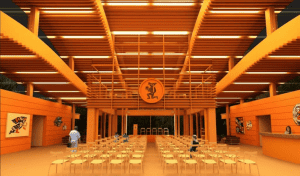I once had a kitten that used to sit in the bedroom windowsill and growl with all her 2-pound might whenever city sanitation trucks pulled up outside to empty our building’s dumpster. With much due appreciation and respect for the workers conducting that essential service, I empathized with the wee feline, convinced that her sounds of displeasure paralleled the expletives occurring in my own rudely-awoken brain at those times.

Noise: While it may not poison water, air, or wildlife, it is, in many places, considered an environmental pollutant.
When we hear the term Environmental Protection Act (EPA), we’re far likelier to think of contaminated land and water than noise. These Acts exist in numerous countries at federal as well as state or provincial levels, but unlike municipal bylaws, they seldom address noise as an environmental hazard. And maybe that needs to change.
Environmental Protection Acts
A perusal of Environmental Protection Acts across four countries reveals that the UK, Australia, and (to a lesser extent) the US all identify noise as a pollutant, while Canada only does so with reference to motor vehicles, aviation, and pipelines in Alberta and BC. In all four countries, noise pollution (and the regulation thereof) is addressed somewhat more at provincial/state levels than federal, but is deemed, for the most part, a municipal responsibility.
The UK addresses noise under Section (79) Statutory nuisances and inspections therefore, and defines related offences as:
- noise emitted from premises so as to be prejudicial to health or a nuisance;
- noise that is prejudicial to health or a nuisance and is emitted from or caused by a vehicle, machinery or equipment in a street.
Regulation enforcement in the UK and parts of the EU has given rise to delightfully memorable acronyms including BATNEEC (Best Available Technique Not Entailing Excessive Cost) and CATNIP (Cheapest Available Technique Not Inviting Prosecution) … the latter triggered my memory of a certain kitten who growled at garbage trucks.

The US introduced a comprehensive Noise Control Act in 1972, but that Act, although never officially rescinded, lost its funding amidst “a shift in federal noise control policy to transfer the primary responsibility of regulating noise to state and local governments.” Noise pollution is currently addressed by the Clean Air Act.
Although the Environment Protection and Biodiversity Conservation Act 1999 (EPBC Act) of Australia is broad in scope, many environmental issues are legislated regionally. Air pollution, for example, is dealt with “under numerous regulations including the Clean Air (Determination of air impurities in gases discharged into the atmosphere) Regulations 1983 (Western Australia) and, as noise pollution is considered air pollution for the purposes of the Western Australian EP Act, the Environmental Protection (Noise Regulations) 1997 (Western Australia).
Similarly, while Canada addresses noise only in terms of motor vehicles, aviation, and pipelines at the federal EPA level, provinces such as Ontario feature numerous laws pertaining to noise pollution. BC, on the other hand, has an Environmental Management Act, but it doesn’t address noise as a pollutant.
LEED by example?
As we’ve seen, environmental protection legislation can vary dramatically, even amongst regions of the same country, so other motivators for green construction do become pertinent.
Leadership in Energy and Environmental Design (LEED) is, as defined by Boston University, “an internationally recognized green building certification system, providing third-party verification that a building or community was designed and built using strategies aimed at improving performance across all the metrics that matter most: energy savings, water efficiency, CO2 emissions reduction, improved indoor environmental quality, and stewardship of resources and sensitivity to their impacts.”
Sounds great, right?
Of course it does! And it is. But like so many Great Things, LEED certification proves problematic in some respects, and its implementation vulnerable to throwing out that proverbial baby with the bathwater. In his illuminating article Acoustics: The Biggest Complaint in LEED-Certified Office Buildings, Buildings editor Chris Curtland writes:
Green initiatives and good acoustic design frequently find themselves at odds, but that doesn’t have to be the case. With a little creativity and consideration, you can integrate these two goals and have a facility that is both sustainable and functional.
Workplaces are doing a poor job of providing acoustical comfort in green facilities, according to the January 2012 white paper Sound Matters by the General Services Administration (GSA). Compared to building conditions such as lighting, air quality, and even thermal comfort—which is notoriously dissatisfying—problems with acoustics are the leading source of complaints, the report reads.
Going back to 2005, poor acoustics have caused the greatest dissatisfaction in renovated LEED-certified offices, according to an occupant indoor environmental quality (IEQ) survey of 23,450 respondents from 142 buildings. Conducted by the Center for the Built Environment (CBE) at the University of California, Berkeley, results appear in the report Acoustic Quality in Office Workstations, as Assessed by Occupant Surveys.
The article goes on to explain that while LEED initiatives such as passive cooling systems (including radiant flooring and chilled beams) can degrade acoustical performance by interfering with sound-absorbing finishes and removing the masking qualities of traditional HVAC systems, educational and healthcare sectors were the first to award points for acoustical design, paving the way for other building types to follow suit.
Quoting The Sextant Group acoustical consultant Gregory A. Coudriet, the article addresses mistakes and misconceptions around LEED practices and their effect on acoustics, concluding that perhaps the greatest myth is that green initiatives and acoustical design are opposed at all. “It’s easy to say green building and acoustics are at odds or incompatible, but I don’t think that’s the case,” Coudriet says. ‘They’re intertwined. Look for opportunities to develop solutions that satisfy both. If the building doesn’t work for its occupants—if it isn’t functional—then is it really sustainable? Green building is all about compromise across systems. Don’t pursue one goal in spite of another.”
So, what does green acoustical design look like?
Perhaps this question renders itself easily answerable when we swap out “green” for the more precise “sustainable”, and sustainable design arises from consideration of environmental impact, as well as health, safety, and profitability. Acoustical treatment can be applied to almost any design project to optimize the comfort level of a space. According to Acoustics.com, an alliance of educators, experts and design professionals dedicated to promoting the importance of acoustics in architecture, design, and construction, sustainable design encompasses far more than use of recycled materials. A design professional must consider:
- Efficiency. Both energy and human efficiency factor into sustainable design. As a company’s most valuable resource, employees necessitate creating a space in which they can thrive. Many studies convincingly document that noise is by far the greatest impediment to workplace productivity.
- Health & Safety. Hearing loss (from noise exposure) is one of the leading occupational hazards—and it’s 100% preventable. Employees that suffer from hearing loss are 55% more likely to have a workplace accident. Other noise-related health issues include headaches, tinnitus, high blood pressure, heart problems, respiratory ailments, and even negative fetal development. If you’d like to read a comprehensively researched and well-written article on the many ways excessive noise impacts our wellbeing, we recommend Things You Need To Know About How Noise Pollution Affects Your Health by Jocelyn T of Home Living Lab.
- Comfort. “Few people have ever experienced real comfort—thermal, visual, or acoustic—but once they do, they tend to want more of it.” (Hawken, Lovin & Lovins. Natural Capitalism) Occupants in a noisy space can feel irritable, distracted, anxious, hostile and annoyed, sometimes without consciously making the connection to noise.
- Functionality/Building Longevity. For a space to be successful, it must function, and if it doesn’t, how can one hope for longevity? An acoustically correct environment is paramount to the functionality of most spaces. You must consider acoustics in any space where:
- speech intelligibility is critical (classroom, courtroom, boardroom, etc.).
- there is a PA system (airport, gymnasium, public building, etc.).
- speech privacy is necessary (open office, call centers, etc.).
- confidentiality is imperative (doctor’s/counselor’s office, HR, attorney’s office, police facility, etc.).
- music is (no pun intended) key (performance space, concert hall, recording studio, etc.).
- both speech and music are important (worship center, ballroom, theater, multi-purpose room, etc.).
- a quiet atmosphere is essential (library, museum, healthcare facility, etc.).
- noise build-up can be problematic (restaurant, lobby, mall, etc.).
- How the Building Impacts the Environment. Facility operation shouldn’t harm (pollute) the environment. Although LEED certification takes into account water, air, land and light pollution, it surprisingly doesn’t include noise pollution. While controlling/limiting light pollution is very important, noise pollution can prove far more annoying, harmful, and difficult to limit.
- Recycled (Sustainable) Materials. Many recycled/sustainable acoustic products work as well as (or better than) non-recycled alternatives. Acoustic products can account for a significant percentage of the materials in a space. Often, most (or all) ceiling, flooring, and wall surfaces serve an acoustical purpose.
At the end of the noisy day, we know that certain levels and frequencies of sound negatively affect human as well as animal health and well-being. In addition to obvious problems such as hearing loss or tinnitus, prolonged exposure to excessive noise can cause stress, high blood pressure, sleep loss, and diminished productivity.
Consider too that, regardless of legislation, the air we breathe—and hear—is really a “commons”, a public good. When we (as individuals and organizations) ignore our obligation to maintain that commons in a way that ensures public comfort, we’re behaving a bit like schoolyard bullies. And who wants to be a bully? No one likes them, and people eventually rat them out.

You don’t want to be this guy. Contact us to learn more about how environmental heroes apply acoustics.




